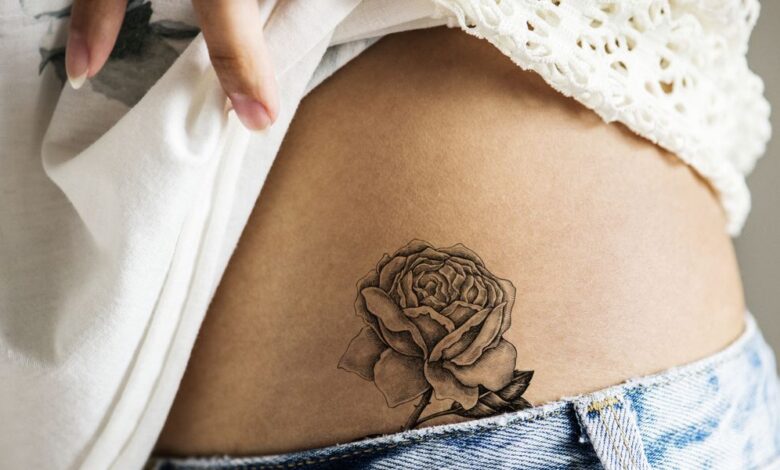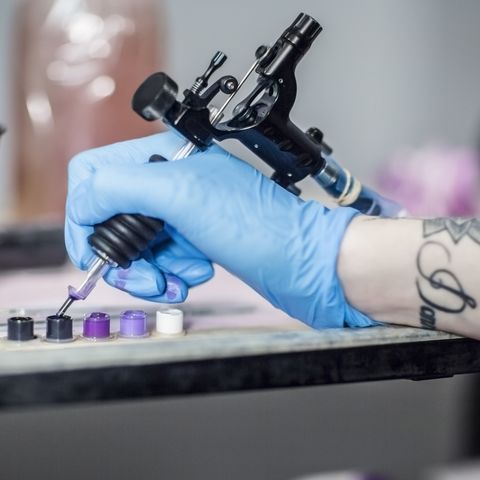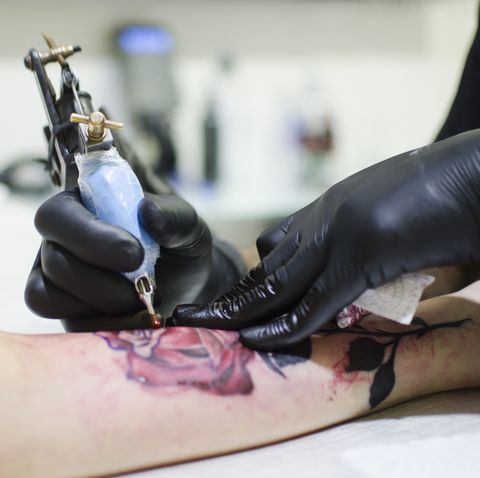What to Do If Tattoo Gets Infected

[ad_1]
I have about 10 tattoos, all done in my thirties, all on the larger side, and most done by the same incredibly talented tattoo artist. Although I’m by no means as inked as some others, I thought I was pretty seasoned when it came to the tattoo-getting experience.
And then the unthinkable happened. No, I didn’t get something spelled wrong. One of my tattoos got infected.
I’d had some gnarly heals with a couple other tattoos — mostly just some thick scabbing — but I’d never seen what was happening to my beautiful new arm art on any of my previous tattoos. First, it started out with a lot more post-appointment pain than in the past, and for a lot longer. I thought it was because of where the tattoo is located — the inner elbow “ditch” is notoriously brutal — so I tried to be patient as several days went by with me being unable to bend and straighten my arm without wanting to scream. Then I noticed that some of the non-inked skin in the area was red and warm to the touch. And finally, after almost a week, the prettiest development of all: goo.
In a panic, I looked up photos of infected tattoos on Instagram, and yikes. It was at this point that I consulted my dermatologist, who prescribed both topical and oral antibiotics. And within a few days the pain and redness — and goo — were gone.
I have no doubt the infection had nothing to do with my artist’s execution and almost entirely to do with the fact that the tattoo was located in one of the sweatiest parts of my body — not to mention that I would find pieces of my dog’s hair sticking it to it no matter how clean I tried to keep the area. But to solve the mystery of how tattoos get infected, we asked the experts — a tattoo artist and two dermatologists. Follow their advice below to lower your risk for infection and get the right treatment should one occur.
1. Carefully consider the body part you want inked.
“Any part of the body is at risk for infection,” says Ife Rodney, M.D., F.A.A.D., board-certified dermatologist and medical director at Eternal Dermatology in Fulton, Maryland. “But places that are prone to more moisture and bacteria — like under the arms, the lip and feet — get infected more easily. Plus, the lower extremities, in general, take a bit longer to heal, making them more prone to infections.” However, you really want to be careful with hands and fingers. “We touch so many different surfaces every day, that these tattoos have the greatest risk, especially since we will need to control ourselves from using our hands while the tattoo heals,” explains Dr. Rodney.
Plus, if there are any signs of skin inflammation (like a rash, redness, broken or irritated skin), Dr. Rodney recommends waiting until the site is completely healed and the skin is normal. “Also, if you are treating an unrelated skin condition using topical medications like a steroid cream, these medications could increase the risk of infection, even if the skin appears normal,” she adds.
2. Find a reputable tattoo parlor and artist.
“While most infections happen in aftercare, some start right at the tattoo parlor,” says Dr. Rodney. “Make sure the tattoo parlor is licensed because licensed parlors are regularly inspected by a health agency. Also, do a little research beforehand to check the safety/infection record of the artist and ask them about their equipment sterilization practices and protocols. They should have no problem with you seeing them in action.”
“Tattoo artists should follow Universal Precautions, the standard for anyone who could be in contact with blood or bodily fluids, and take blood borne pathogen training,” explains Joe Lathe-Vitale, a shop owner and tattoo artist for 20 years. “An artist who’s properly trained and using good safety measures will greatly minimize any chance of infection.” Lathe-Vitale says a properly trained tattoo artist will always use sterile, single-use needles, and properly sterilize and clean any materials that are reused; however, most artists now use entirely single-use disposable items. You’ll also want to make sure they use new gloves with each client and change gloves as needed during the procedure, Dr. Rodney points out.
Remember, your artist is also responsible for making sure the skin is properly prepped before starting. “You can develop an infection if the skin isn’t adequately cleaned before getting a tattoo,” says Joshua Zeichner, M.D., board-certified dermatologist and Director of Cosmetic and Clinical Research at the Mount Sinai Hospital Department of Dermatology.
3. Stay diligent during the healing process.
Even if your artist does everything correctly, what happens after you leave the shop is the key to healthy healing. “A tattoo that is properly done by a reputable artist is pretty resilient. It will heal if just left alone and kept clean,” Lathe-Vitale says. “It’s outside bacteria that can cause problems.”
Although every artist has preferences for after-care, most emphasize how important it is to keep the tattooed skin moisturized and clean — which means avoiding some very normal behaviors that would otherwise be harmless. “In my opinion, the most important thing is for a client to never touch the tattoo without first washing their hands,” says Lathe-Vitale, even before applying any moisturizer or ointment. Additionally, he says it’s best not to soak your new tattoo in a tub, use body scrub on it or let your pet lick or scratch it.
4. Know the signs of infection.
If you’ve ever gotten a tattoo, you know it’s par for the course to have pain and swelling after a session — and both Dr. Rodney and Dr. Zeichner agree that’s normal. However, anything beyond that may be cause for concern, especially if symptoms last for three or more days. “If you are developing significant warmth, redness or tenderness, you may have developed an infection,” says Dr. Zeichner. “If you feel unwell or have a fever or any pus in the area of the tattoo, these can be other signs of an infection.” You’ll also want to be aware of leaking ink or excessive itching, notes Dr. Rodney.
5. Get a proper diagnosis.
Even if your previous tattoos have healed perfectly, it’s imperative to consult a board-certified dermatologist if you have signs of an infection. “Other conditions, like allergic reactions to tattoo ink, may present in a similar manner, with redness, itching and swelling,” says Dr. Rodney. “As treatment for both of these conditions is different, it is best to figure out the correct diagnosis ASAP.”
She says a dermatologist will usually perform a physical exam, looking and feeling for signs of an infection or allergic reaction. “If the infection appears serious or if it does not resolve with the initial treatment, we may take a culture of the skin,” explains Dr. Rodney. “This is a simple swab that is sent to the lab to figure out the exact type of bacteria that is causing the infection, and the best treatment for it. For the most resistant infections, a skin biopsy may be done, in which a small tissue sample of skin is sent to a lab for testing.”
6. Don’t try to treat it yourself.
You cannot count on an infection to clear up without medication. “If not treated, infections typically do not resolve on their own,” says Dr. Zeichner. “They can grow in size and become quite large and tender. As with any skin infection, in severe cases bacteria can enter your bloodstream and actually become life-threatening.”
Keep in mind, tattoo infections are usually deeper in the skin as the needle pierces 1.5 to 2 mm into the skin, notes Dr. Rodney, so an OTC antibiotic ointment isn’t going to cut it. “Depending on the severity of the infection, your dermatologist may prescribe a prescription topical antibiotic,” Dr. Zeichner explains. “In some severe cases, you may receive an oral antibiotic instead.”
If you try to treat an infection on your own, you could delay the treatment and end up with scarring. “Not only is this risky, but it can also ruin the appearance of your new tattoo,” says Dr. Rodney. “The infected skin may not heal correctly, leaving an unsightly scar or an abscess that needs to be drained by a doctor.”
7. Be prepared to have your tattoo fixed.
“If an infection occurs, it’s not the end of the world,” says Lathe-Vitale. “Once it’s cleared up, the tattoo can always be touched up if necessary.” The important thing is to wait until the skin has fully recovered because an infection can hinder the healing of the original tattoo. “This may mean that tattoo pigment is not properly retained in the skin,” explains Dr. Zeichner. “It’s okay to get a touch up; however, I recommend waiting at least one to two months after the infection has resolved to make sure that the skin is fully healed.” At that point, Lathe-Vitale advises letting your artist visually inspect the tattoo to determine if it’s ready.
This content is created and maintained by a third party, and imported onto this page to help users provide their email addresses. You may be able to find more information about this and similar content at piano.io
[ad_2]
Source link






